Nazareth Houses
In 1851, following a request from the Archbishop of Westminster, Cardinal Wiseman, to the Little Sisters of the Poor in the French town of Rennes, where they ran a house to care for the elderly poor, a party of four nuns was sent to set up a similar establishment in London. Amongst the group was Sister Basile Marie Larmenier (formerly Victoire Larmenier), who was appointed the group's Superior. After several changes of premises, the Sisters managed to build the first permanent Nazareth House, opened in October 1857 at Hammersmith. As well as the elderly poor, the home provided accommodation for destitute and orphan Roman Catholic children.
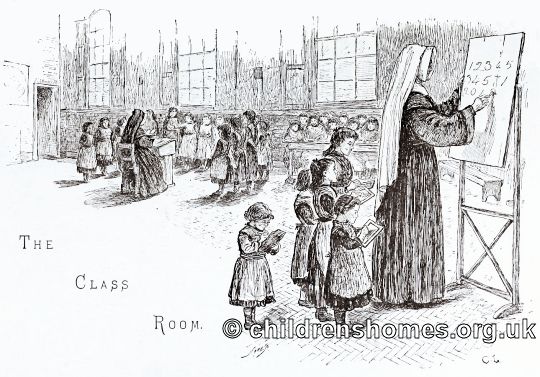
Classroom at Nazareth House, Hammersmith, c.1889. © Peter Higginbotham
In 1861, the group separated from the Little Sisters of the poor and formed a new Order known as the Sisters of Nazareth (or sometimes the Poor Sisters of Nazareth). Larmenier, who then adopted the name Sister St Basil, is now regarded of as the founder of the Order. By the time of her death in June 1878, Larmenier had established a further eight Nazareth Houses although one of these was retained by the Little Sisters of the Poor in 1861. The practice that applied in most of the Nazareth homes was for boys and girls to be admitted from around the age of two, with girls remaining until they were fourteen or so, many then going into domestic service. On reaching the age of seven, the boys usually transferred to other Catholic-run homes, with a small number of Nazareth Houses, such as Southend and Swansea, also accommodating older boys.
Larmenier's successor was Margaret Owen Mother Mary of the Nativity, under whose leadership the Order expanded across the world. When she died in 1908, an additional 22 Nazareth Houses had been founded, their locations including Australia, New Zealand and South Africa, as well as Britain.
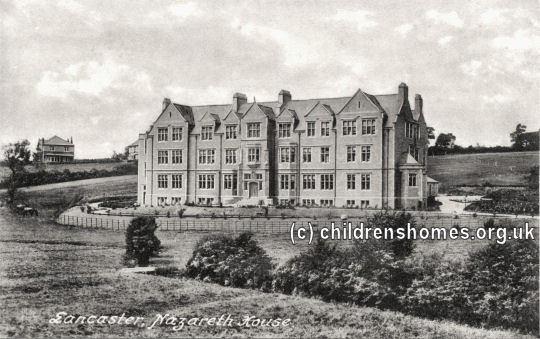
Nazareth House, Lancaster, date unknown. © Peter Higginbotham
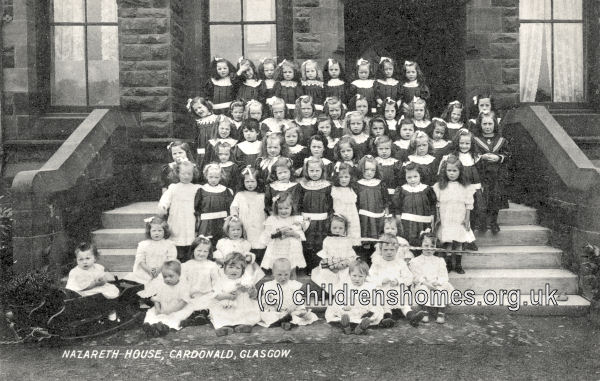
Nazareth House, Glasgow, young inmates, c.1914. © Peter Higginbotham

Nazareth House, Glasgow, elderly men's dayroom, c.1914. © Peter Higginbotham
The head of the Order from 1909 to 1922 was Henrietta Greene Mother Clare of the Cross, during whose tenure 11 more Nazareth Houses were established. She was followed by Elizabeth Murphy Mother Macnise who oversaw 20 more foundations including ones in the USA and Southern Rhodesia (now Zimbabwe). The Order's Superior General from 1946 to 1958 was Honora Hough Mother Emmanuel Mary who introduced a broader range of professional training for the Sisters including nursing, childcare, catering and teaching. During this period, the Order also participated in a child emigration scheme and set up a reception and training home at Geraldton in Western Australia.
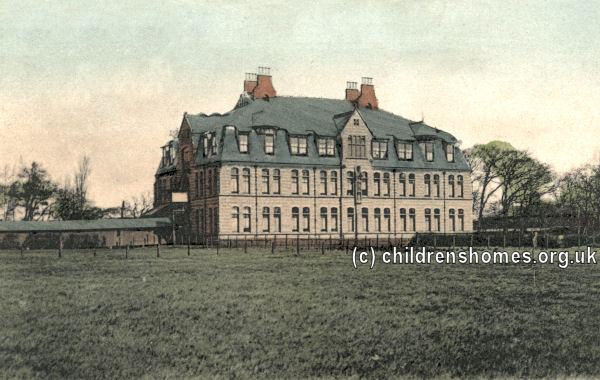
Nazareth House, Great Crosby, Liverpool, early 1900s. © Peter Higginbotham
The Order's seventh Superior General, from 1970 to 1976 was Julia Kelly Mother Alphonsus Joseph. No new Nazareth Houses were opened, but at the end of her term of office, there were 47 Nazareth Houses operating in seven countries and providing care for 4,284 elderly men and women, 2,171 babies, and 1,723 children.
The end of the Order's provision of residential child care, at least as far as the UK, Ireland and Australia were concerned, came during the tenure of Ursula Patricia Comerton Mother Mary Austin from 1976 to 1988. The steadily growing use of fostering led to a fall in the demand for residential places, something which affected all the traditional children's home operators. The Nazareth Houses' long tradition of providing care for the elderly continued, however, an area which continues to expand. Nonetheless, more recent years have seen the closure of a number of the UK Nazareth Houses including those at Kilmarnock, Aberdeen, Middlesbrough, Nottingham, Ditton, Wrexham, Bexhill and Isleworth.
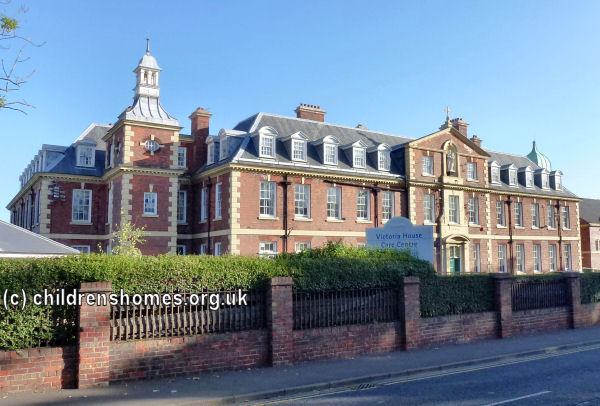
Former Nazareth House, Middlesbrough, 2013. © Peter Higginbotham
From the 1990s onwards, allegations by former residents of a number of the Nazareth Houses began to surface about the cruelty and abuse to which they had been subjected. Some of them subsequently launched legal actions against the Sisters. In 2006, some victims of abuse at Nazareth House homes were paid compensation by the UK Government's Criminal Injuries Compensation Authority. In 2014, at a hearing of the Northern Ireland Historical Institutional Abuse inquiry, the Sisters of Nazareth accepted that children in their care had been abused. They offered their sincere and unreserved apology to all those whom they failed to protect. It was revealed that girls at the Londonderry Nazareth House had sometimes been punished by being bathed in disinfectant or forced to eat their own vomit. One girl had been made to clear a blocked toilet by removing the accumulated excrement with her bare hand.
Records
Note: many repositories impose a closure period of up to 100 years for records identifying individuals. Before travelling a long distance, always check that the records you want to consult will be available.
- Sisters of Nazareth Archive, Sisters of Nazareth Archive, Nazareth House, 169-175 Hammersmith Road, London W6 8DB. The archivist is Christine Hughes. The archive contains material from the very beginnings of the order in the 1850s up until the present day. The archive is not open to the public and does not have facilities for personal searchers, although exceptions can be made for Sisters and for academic researchers. Enquiries are welcomed by post only for privacy and confidentiality reasons and replies are by also letter. There is no fee for dealing with enquiries, although donations to the Sisters are appreciated.
Bibliography
- Fothergill, Anne Memoirs of a Nazareth House Girl (2013, Quoin Publishing). Memories of the Middlesbrough Nazareth House.
- Gray-Wilson, Shirley It isn't Always Raining: Children in Care, 1939-1948 (2000). Life in the Carlisle and Newcastle Nazareth Houses.
- Kelly, Judith Rock Me Gently: A Memoir Of A Convent Childhood (2006, Bloomsbury). A memoir of life at Bexhill Nazareth House in the early 1950s. The factual veracity of this book has been challenged, and charges of plagiarism levelled against the author (e.g. see Catholic Herald 2/9/2005). The introduction to the current edition of the book acknowledges some of these criticisms.
- Reilley, Frances Suffer The Little Children: The True Story of An Abused Convent Upbringing (2009, Orion). Memories of the Belfast Nazareth House.
- Nuns 'abused hundreds of children' (Guardian article 16/8/1998)
- Sisters of No Mercy (Guardian article 1/4/2003)
- Compensation for care homes abuse (BBC News item 15/8/2006)
- Sisters of Nazareth become second Catholic order to admit to child abuse (Guardian article 14/1/2014)
- Children at Derry care homes were made to eat vomit, inquiry told (Guardian article 27/1/2014)
- A Time for Penance? (BBC Scotland 'Frontline' TV feature on abuse in Scottish Nazareth Houses)
Links
Except where indicated, this page () © Peter Higginbotham. Contents may not be reproduced without permission.


